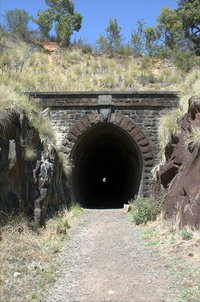
Swan View Tunnel
Encyclopedia

Swan View, Western Australia
Swan View is an eastern suburb of Perth, Western Australia. Its Local Government Areas are the City of Swan and the Shire of Mundaring, and it is located from Perth in an area known as the Perth Hills on the edge of the Darling Scarp, just to the west of the John Forrest National Park, east of Roe...
, Western Australia
Western Australia
Western Australia is a state of Australia, occupying the entire western third of the Australian continent. It is bounded by the Indian Ocean to the north and west, the Great Australian Bight and Indian Ocean to the south, the Northern Territory to the north-east and South Australia to the south-east...
on the edge of the Darling Scarp
Darling Scarp
The Darling Scarp, also referred to as the Darling Range or Darling Ranges, is a low escarpment running north-south to the east of the Swan Coastal Plain and Perth, Western Australia...
. Currently inactive, due to its location (31°52′55.51"S 116°4′15.59"E to 31°53′2.76"S 116°4′4.89"E) within the John Forrest National Park
John Forrest National Park
John Forrest National Park is a national park in the Darling Scarp, 24 km east of Perth, Western Australia. It was the first national park in Western Australia and the second in Australia after Royal National Park.- Name :...
, the tunnel and its adjacent landscape exist within a conserved state. Prior to the construction of tunnels for the Mandurah line in 2004, the Swan View Tunnel was the only tunnel built for the Western Australian railway network.
Construction
It was built on an alignment which replaced the original Eastern Railway passing through Smiths Mill, Glen Forrest, and Mundaring. The project to build the new line, including the Swan View Tunnel, was managed by C Y O'Connor, who, at the time, was Engineer-in-Chief of Western Australia's Government Railways. Work began in 1894, and was completed in 1895, at a cost of about £12,000. The unstable nature of the jointed granite, along with clay seams, caused difficulties during construction of the tunnel. A masonry-lined face prevented rock falls, but reduced the inner diameter.The tunnel's small diameter combined with the steep gradient (1:49) to cause smoke accumulation. Incidents involving near-asphyxiation of train crews started in 1896, and continued throughout the tunnel's operating life. The first serious incident of this nature was in 1903.
The tunnel's design was incompatible with the ASG
Australian Standard Garratt
The Australian Standard Garratt was a Garratt steam locomotive designed in Australia during the Second World War, which was used on narrow gauge railway systems in Queensland, South Australia, Western Australia and Tasmania.- Overview :...
class Garratt steam locomotives used by the Western Australian Government Railways
Western Australian Government Railways
Western Australian Government Railways was most common name of the Western Australian government rail transport authority from 1890 to 1976. It is, in its current form, known as the Public Transport Authority of Western Australia....
in the 1940s. The worst accident in the tunnel was in 1942, when several train crew workers were asphyxiated, one dying, when a fully laden train passed through the tunnel at walking pace, due to the excessive grade.
Between 1934 and 1945, a signal cabin was located at Tunnel junction, on the eastern end of the tunnel, for managing the transition from the tunnel's single line to the dual lines of the system. The single line tunnel was insufficient for traffic, and a diversion was added on the northern side of the hill that the tunnel passed through. The diversion was completed on 25 November 1945.
Railway closure
The railway line through the tunnel was lifted after the closing of the older and steeper Eastern Railway and the building of the Avon Valley diversion completed in 1966.After the 1960s, gates/doors were put at either end of the tunnel though these were later removed.
The tunnel remains intact, and is part of the John Forrest Heritage Trail (a component of the larger Railway Reserve Heritage Trail
Railway Reserve Heritage Trail
Railway Reserves Heritage Trail, also on some maps as Rail reserve heritage trail or Rail reserves historical trail - and frequently referred to locally as the 'Bridle Trail' or 'Bridle Track' , is within the Shire of Mundaring in Western Australia....
). During the 1990s, the government authority in which the tunnel land is now vested - the Department of Environment and Conservation (Western Australia) (known as DEC and formerly known by the abbreviation CALM) allowed a number of night time 'Ghost walks' in the tunnel as part of the Hills Forest programmes, based at the Mundaring Weir
Mundaring Weir
Mundaring Weir is the name of a dam which are located from Perth, Western Australia in the Darling Scarp. It is situated in the Mundaring locality...
headquarters of DEC .

